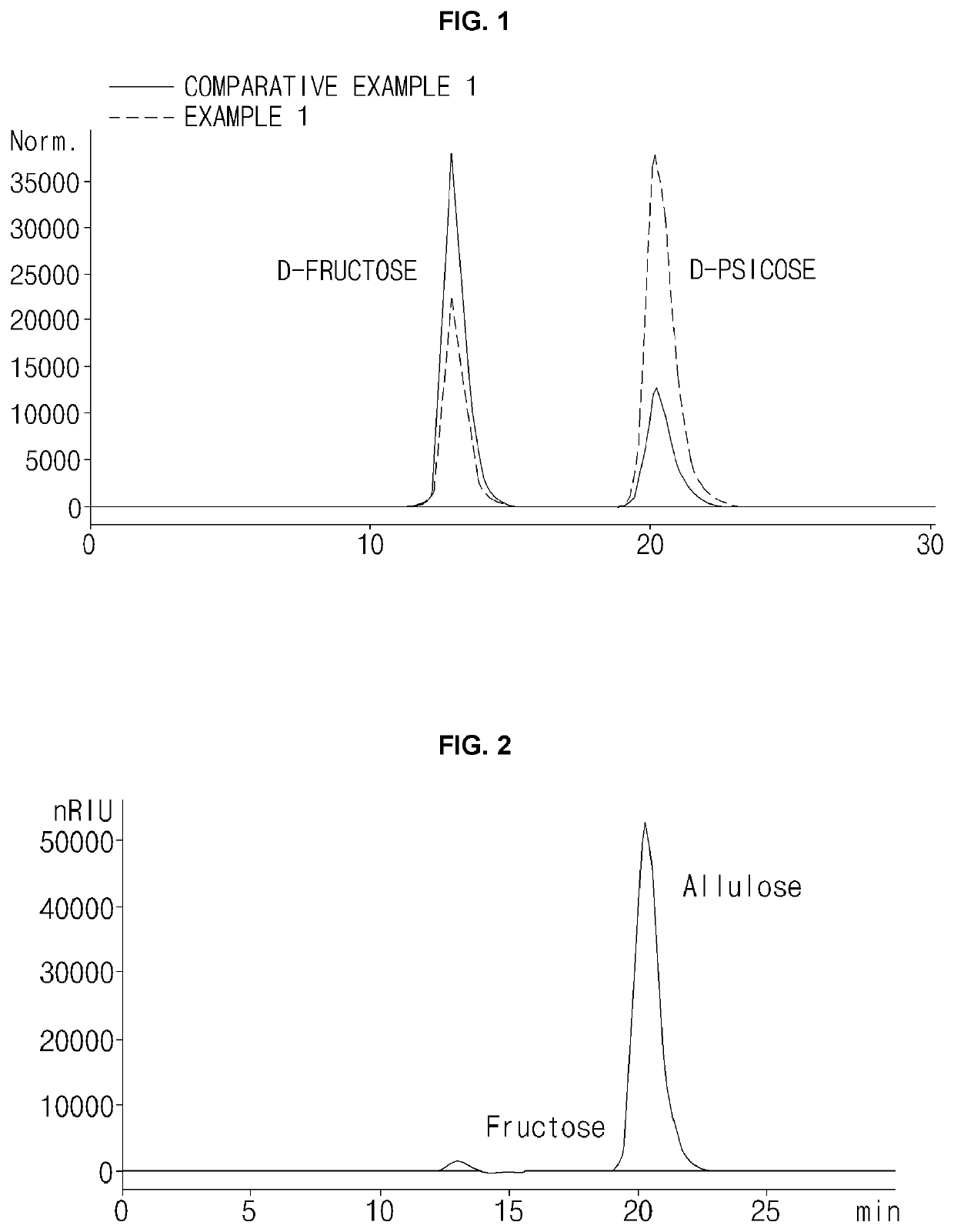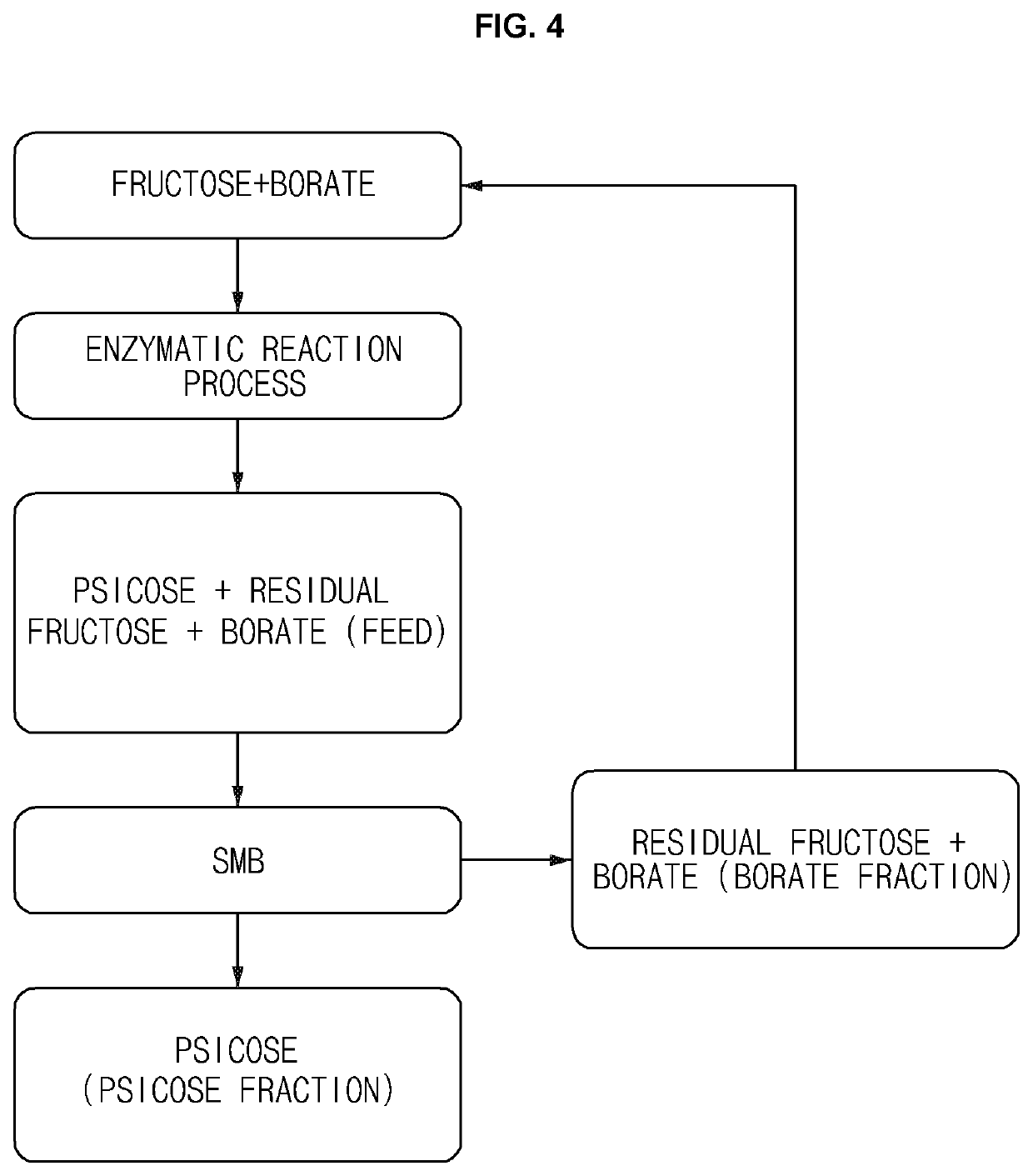Method for producing d-psicose from d-psicose borate complex using chromatography and composition containing d-psicose
a technology of dpsicose and borate complex, which is applied in the direction of cation exchanger materials, racemaces/epimerases, separation processes, etc., can solve the problems of poor economic feasibility for industrialization and increase the cost of bleaching, and achieve efficient separation and removal.
- Summary
- Abstract
- Description
- Claims
- Application Information
AI Technical Summary
Benefits of technology
Problems solved by technology
Method used
Image
Examples
example 1
Production of D-Psicose using Borate and Enzymatic Conversion Method
[0047]An enzymatic conversion reaction was carried out using Corynebacterium glutamicum (KCCM11403P), which is a recombinant strain known to express a variant of a psicose epimerase derived from Agrobacterium tumefaciens (Korean Patent No. 10-1455759). 0.1 M fructose was dissolved in water and 0.05 M borate and 10 mM MnCl2 were added thereto (experimental example 1) or only 10 mM MnCl2 was added thereto (comparative example 1) to prepare a raw material for enzymatic conversion reaction. Then, the strain (20% w / w) was added to the raw material and the reaction was carried out for 3 hours under the condition of pH of 8.0 and the temperature of 55° C.
[0048]Afterwards, the conversion rate was calculated by comparing the peak area values of the substrate (D-fructose) of the psicose epimerization enzyme and the product (psicose) through HPLC analysis, and the HPLC analysis was performed under the conditions that the sampl...
example 2
Borate Separation
[0050]2-1. Confirmation of Borate Separation using SMB Chromatography
[0051]An SMB (Simulated Moving Bed) chromatography was used to separate borate-removed D-psicose from a composition comprising D-psicose borate complex (borate, D-fructose and D-psicose, hereinafter referred to as “feed”). The SMB chromatography used an advanced simulated moving-bed system (Organo, Japan) instrument, and the instrument includes successively connected six columns (each having a height of 1.2 m, and a diameter of 4.3 cm), a feed pump, a recirculation pump, an eluent pump, a heat exchanger and a valve for controlling flow rate. The conditions for operating the SMB chromatography are as the Table 1 below.
TABLE 1Mixture of fructose, psicoseFeedand borateFeed concentration60% (w / w)Cation exchange resinAmberlite (Amberlite (adsorbent) filled in columnsCR-1310; Ca-type)Size and number of columns43 mm × 1200 mm * 6 columnsDesorbent (eluent)OFlow speed2.49 m / HEluent temperature60° C.
[0052]Ad...
PUM
| Property | Measurement | Unit |
|---|---|---|
| pH | aaaaa | aaaaa |
| pKa | aaaaa | aaaaa |
| temperature | aaaaa | aaaaa |
Abstract
Description
Claims
Application Information
 Login to View More
Login to View More - R&D
- Intellectual Property
- Life Sciences
- Materials
- Tech Scout
- Unparalleled Data Quality
- Higher Quality Content
- 60% Fewer Hallucinations
Browse by: Latest US Patents, China's latest patents, Technical Efficacy Thesaurus, Application Domain, Technology Topic, Popular Technical Reports.
© 2025 PatSnap. All rights reserved.Legal|Privacy policy|Modern Slavery Act Transparency Statement|Sitemap|About US| Contact US: help@patsnap.com



